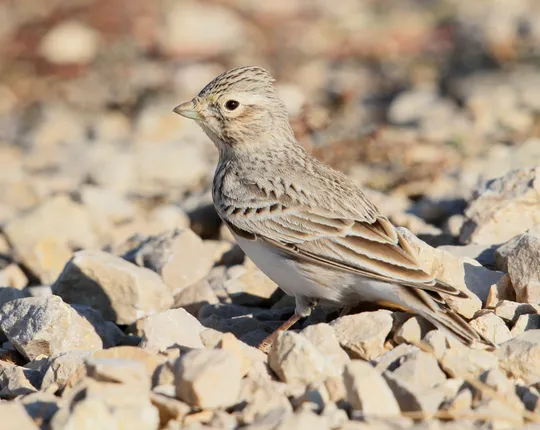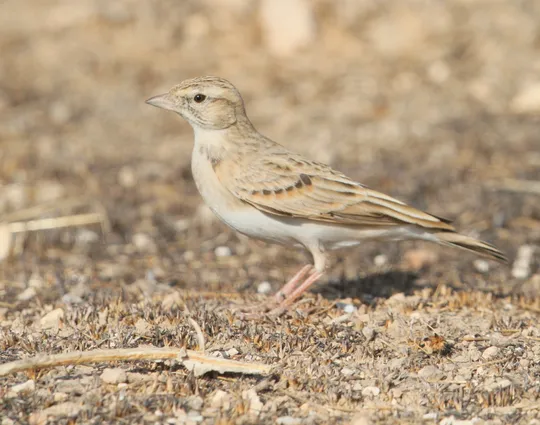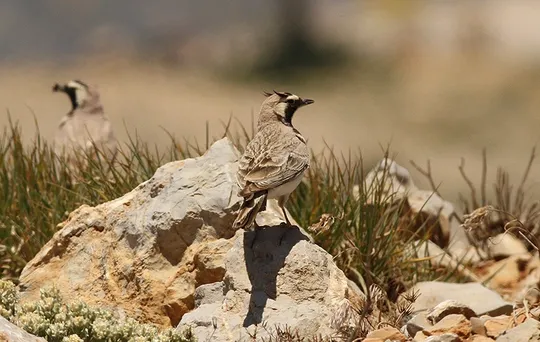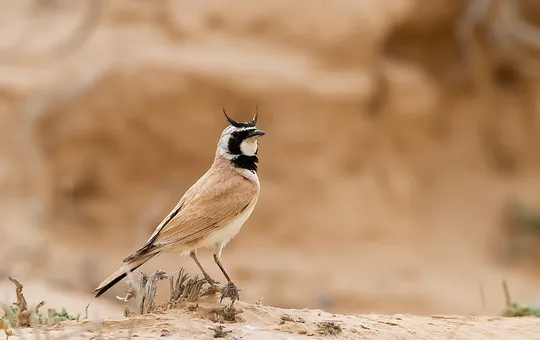Alaudala rufescens
 Vulnerable
Vulnerable



| Habitats | Desert Plains, Inland Sand Dunes |
|---|---|
| Presence In Israel | Summer, Migrant, Resident |
| Breeding In Israel | Breeder |
| Migration Types | Resident, Nomad |
| Zoographical Zones | Irano-Turanian, Saharo-Arabian |
| Landscape Types | Plains & Valleys, Wide Wadis, Sand Dunes |
| Vegetation Types | Steppe, Herbaceous |
| Vegetation Densities | Low |
| Nest Locations | Ground |
| Diet Types | Herbivore |
| Foraging Grounds | Ground |
| Body Sizes | Small (up to 500g) |
| Threat Factors | Overgrazing, Direct disturbance from human activity, Increased predation from invasive and eruptive species |
The Lesser Short-toed Lark is a small, delicate lark, with a pale brown plumage, tending to rufous, and a streaked back and breast. It has a short, thick bill. The male has a hoarse, fluent rattling song, with extensive mimicry of other bird songs. Usually performed while flying high in the air.
A relatively rare resident and summer visitor in the Western Negev, particularly in the Halutsa Sands, Agur Sands and Nitsana area. After rain events, it sometimes nests in other areas in the central and southern Negev. Until the 2000s, it was very common in the Western Negev sands, but in recent years, there has been a significant decline in the number of Lesser Short-toed Larks in these areas, to the point of complete absence in some years.
The Lesser Short-toed Lark inhabits broad wadis and sandy and loess flats with sparse low vegetation.
Its threat factors are not sufficiently understood, but observations on Lesser Short-toed Lark habitats in the Western Negev show them to be disturbed by intensive grazing of livestock, accompanied by dogs, direct disturbance by military and off-road vehicle activity, and the impact of agricultural expansion, including invasive and eruptive species.
No specific conservation measures have been taken for this species to date.
- פז, ע. 1986. עופות. מתוך אלון, ע. (עורך), החי והצומח של ארץ ישראל. כרך 6. הוצאת משרד הביטחון, ישראל.
- Perlman, Y., Shochat, E. and Labinger, Z. 2011. Developing Managment plan for important bird areas in southern Israel. second annual report, Nizzana region and Arava Valley.Israeli Ornithological center, SPNI.
- Shirihai, H., 1996. The Birds of Israel. Academic Press, London.
- Symes, A. 2013. Species generation lengths. Unpublished, BirdLife International.
- Species page at Birdlife International
Current Occupancy Map
| Data Missing | Sporadic | Limited Sites | Low Density | High Density |
|---|---|---|---|---|
| 0 | 0 | 0 | 0 | 0 |
Distribution maps
The maps presented here provide visual information on the distribution of species in Israel from the past and present, and the changes in occupancy and breeding density during the comparison period. For further reading
Relative Abundance 2010-2020
Breeding density values in the current decade as determined from experts' opinion and observations from databases.
| Data Missing | Sporadic | Limited Sites | Low Density | High Density |
|---|---|---|---|---|
| 8 | 12 | 12 | 21 | 19 |
Relative Abundance 1980-1990
Density values based primarily on the book The Birds of Israel (Shirihai 1996).
| Data Missing | Sporadic | Limited Sites | Low Density | High Density |
|---|---|---|---|---|
| 5 | 14 | 14 | 17 | 22 |
Occupancy 1990-2020
The map shows differences in the species breeding distribution between the 1980's breeding map and the current weighted breeding evaluation. Negative value - species previously bred in the grid and is not presently breeding; positive value - species has not previously bred in the grid and is currently breeding.
| Data Missing | No Change | Occupancy Increase | Occupancy Decrease |
|---|---|---|---|
| 6 | 35 | 1 | 9 |
Change in Relative Abundance 1990-2020
The map shows the changes in the relative abundance of a species in each of the distribution grids between the breeding map of the 1980s and the weighted current breeding evaluation. Negative values - decline in abundance; positive values - increase in abundance; zero - no change in abundance.
| 80 to 100 | 50 | 20 to 30 | No Change | 30- to 20- | 50- | 100- to 80- | Data Missing |
|---|---|---|---|---|---|---|---|
| 0 | 4 | 2 | 22 | 12 | 14 | 11 | 16 |
| Rarity | |
|---|---|
| Vulnerability | |
| Attractiveness | |
| Endemism | |
| Red number | |
| Peripherality | |
| IUCN category | |
| Threat Definition according to the red book |
 Contributed:
Contributed: 





